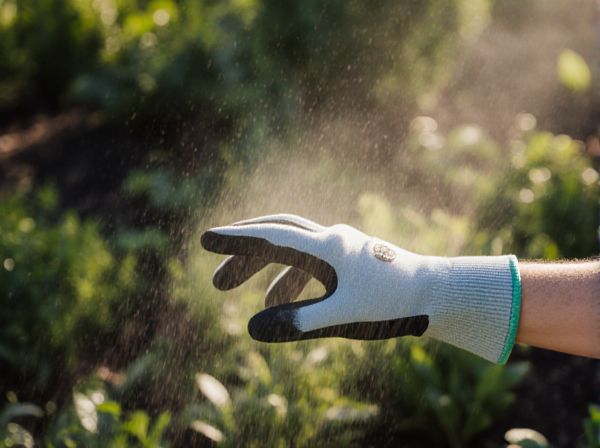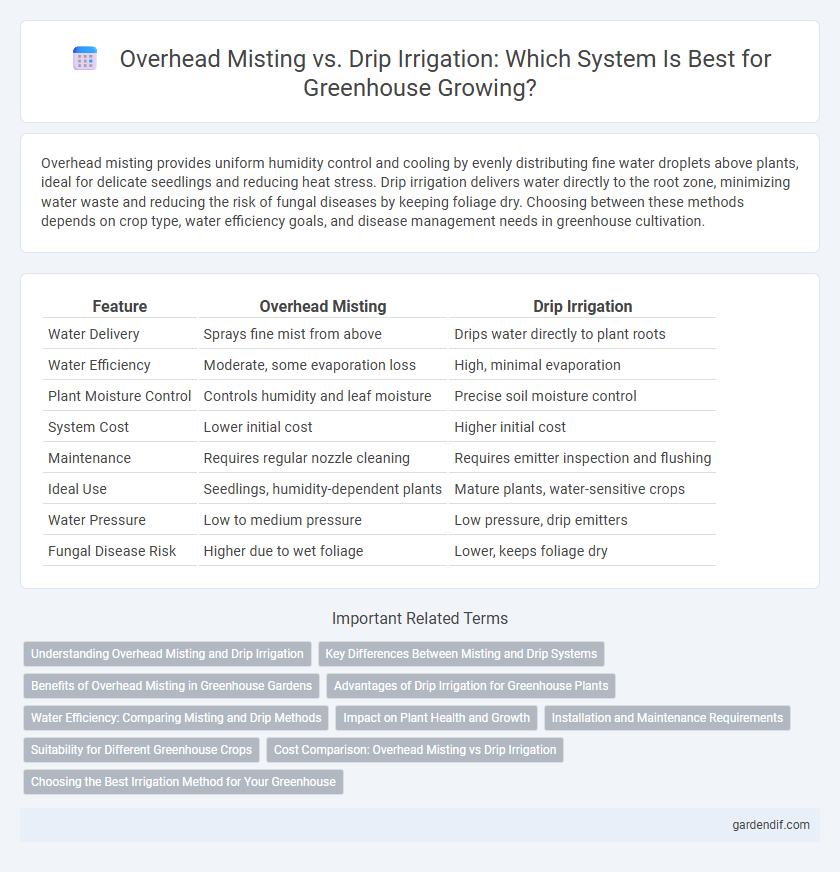
Overhead Misting vs Drip Irrigation Illustration
Overhead misting provides uniform humidity control and cooling by evenly distributing fine water droplets above plants, ideal for delicate seedlings and reducing heat stress. Drip irrigation delivers water directly to the root zone, minimizing water waste and reducing the risk of fungal diseases by keeping foliage dry. Choosing between these methods depends on crop type, water efficiency goals, and disease management needs in greenhouse cultivation.
Table of Comparison
| Feature | Overhead Misting | Drip Irrigation |
|---|---|---|
| Water Delivery | Sprays fine mist from above | Drips water directly to plant roots |
| Water Efficiency | Moderate, some evaporation loss | High, minimal evaporation |
| Plant Moisture Control | Controls humidity and leaf moisture | Precise soil moisture control |
| System Cost | Lower initial cost | Higher initial cost |
| Maintenance | Requires regular nozzle cleaning | Requires emitter inspection and flushing |
| Ideal Use | Seedlings, humidity-dependent plants | Mature plants, water-sensitive crops |
| Water Pressure | Low to medium pressure | Low pressure, drip emitters |
| Fungal Disease Risk | Higher due to wet foliage | Lower, keeps foliage dry |
Understanding Overhead Misting and Drip Irrigation
Overhead misting systems distribute fine water droplets uniformly over greenhouse plants, promoting humidity control and cooling while reducing water waste through targeted spray patterns. Drip irrigation delivers water directly to the root zone via emitters, enhancing water efficiency and minimizing disease risk by keeping foliage dry. Choosing between overhead misting and drip irrigation depends on crop type, water needs, and climate control requirements within the greenhouse environment.
Key Differences Between Misting and Drip Systems
Overhead misting systems provide uniform humidity and temperature control by spraying fine water droplets over plants, promoting transpiration and cooling effects, whereas drip irrigation delivers precise amounts of water directly to the root zone, optimizing water efficiency and reducing runoff. Misting is ideal for delicate seedlings and humidity-loving plants but can increase the risk of fungal diseases due to surface wetness, while drip systems minimize leaf wetness, lowering disease incidence and supporting deep root growth. The choice between misting and drip irrigation hinges on specific crop requirements, greenhouse climate control needs, and water conservation goals.
Benefits of Overhead Misting in Greenhouse Gardens
Overhead misting in greenhouse gardens enhances humidity control and provides uniform water distribution, promoting healthier plant growth and reducing water waste. It effectively cools the environment, preventing heat stress and maintaining optimal conditions for sensitive crops. This method also minimizes soil saturation and root diseases compared to drip irrigation, leading to improved plant health and yield.
Advantages of Drip Irrigation for Greenhouse Plants
Drip irrigation delivers water directly to the root zone of greenhouse plants, reducing evaporation and water waste while promoting efficient nutrient absorption. This method minimizes leaf wetness, decreasing the risk of fungal diseases commonly associated with overhead misting. Precise control over water distribution enhances growth uniformity and conserves water, making drip irrigation an environmentally sustainable choice for greenhouse environments.
Water Efficiency: Comparing Misting and Drip Methods
Overhead misting systems deliver fine water droplets that quickly evaporate, resulting in higher water loss compared to drip irrigation, which targets the root zone directly and minimizes evaporation. Drip irrigation can reduce water usage by up to 50% compared to overhead misting, enhancing water efficiency in greenhouse environments. Optimizing irrigation techniques with drip systems promotes sustainable water management and healthier plant growth by maintaining consistent soil moisture levels.
Impact on Plant Health and Growth
Overhead misting provides uniform humidity and cooling effects that enhance photosynthesis and reduce heat stress, promoting vigorous plant growth in greenhouse environments. Drip irrigation delivers water directly to the root zone, minimizing fungal diseases and water wastage while optimizing nutrient uptake, which supports healthier root systems and steady development. Combining both methods strategically can balance moisture and aeration, maximizing overall plant health and yield.
Installation and Maintenance Requirements
Overhead misting systems require precise installation of nozzles and plumbing to ensure uniform water distribution, often demanding professional setup due to complexity and calibration needs. Drip irrigation involves simpler installation with emitters placed directly at the plant base, reducing water waste and easing maintenance through straightforward emitter replacements and line flushing. Maintenance for overhead misting includes regular nozzle cleaning to prevent clogging, while drip irrigation primarily requires periodic inspection for leaks and emitter blockages to maintain efficiency.
Suitability for Different Greenhouse Crops
Overhead misting suits delicate leafy greens and seedlings that require uniform humidity and gentle hydration, preventing soil erosion and minimizing disease risk. Drip irrigation is ideal for fruiting crops like tomatoes and peppers, delivering precise water directly to the root zone, enhancing nutrient uptake and reducing water waste. Crop-specific water needs and growth stages determine the choice between overhead misting and drip irrigation for optimal greenhouse productivity.
Cost Comparison: Overhead Misting vs Drip Irrigation
Overhead misting systems generally have lower initial installation costs compared to drip irrigation due to simpler setup and fewer components. However, drip irrigation offers greater water efficiency and reduced operational costs over time by delivering water directly to plant roots, minimizing evaporation and runoff. Considering long-term expenses, drip irrigation often proves more cost-effective in greenhouse environments where precision watering is crucial.
Choosing the Best Irrigation Method for Your Greenhouse
Overhead misting systems provide uniform humidity control and cooling, ideal for delicate seedlings and humidity-loving plants in greenhouses. Drip irrigation delivers precise water directly to the root zone, reducing water waste and minimizing disease risk, making it suitable for mature plants with specific moisture needs. Selecting the best irrigation method depends on plant type, growth stage, and greenhouse climate requirements to ensure optimal water efficiency and plant health.
Overhead Misting vs Drip Irrigation Infographic

 gardendif.com
gardendif.com